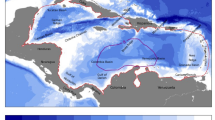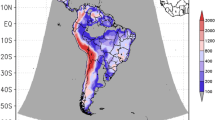Abstract
Statistical downscaling of 14 coupled atmosphere-ocean general circulation models (AOGCM) is presented to assess potential changes of the 10 m wind speeds in France. First, a statistical downscaling method is introduced to estimate daily mean 10 m wind speed at specific sites using general circulation model output. Daily 850 hPa wind field has been selected as the large scale circulation predictor. The method is based on a classification of the daily wind fields into a few synoptic weather types and multiple linear regressions. Years are divided into an extended winter season from October to March and an extended summer season from April to September, and the procedure is conducted separately for each season. ERA40 reanalysis and observed station data have been used to build and validate the downscaling algorithm over France for the period 1974–2002. The method is then applied to 14 AOGCMs of the coupled model intercomparison project phase 3 (CMIP3) multi-model dataset. Three time periods are focused on: a historical period (1971–2000) from the climate of the twentieth century experiment and two climate projection periods (2046–2065 and 2081–2100) from the IPCC SRES A1B experiment. Evolution of the 10 m wind speed in France and associated uncertainties are discussed. Significant changes are depicted, in particular a decrease of the wind speed in the Mediterranean area. Sources of those changes are investigated by quantifying the effects of changes in the weather type occurrences, and modifications of the distribution of the days within the weather types.


















Similar content being viewed by others
References
Alexander LV, Tett SFB (2005) Recent observed changes in severe storms over the United Kingdom and Iceland. Geophys Res Lett 32:L13704. doi:10.1029/2005GL022371
Archer CL, Jacobson MZ (2005) Evaluation of global wind power. J Geophys Res 110:D12110. doi:10.1029/2004JD005462
Bärring L, von Storch H (2004) Scandinavian storminess since about 1800. Geophys Res Lett 31:L20202. doi:10.1029/2004GL020441
Boé J, Terray L, Habets F, Martin E (2006) A simple statistical-dynamical downscaling scheme based on weather types and conditional resampling. J Geophys Res 111:D23106. doi:10.1029/2005JD006889
Bogardi I, Matyasovszky I (1996) Estimating daily wind speed under climate change. Solar Energy 57-3:239–248
Cassou C, Terray L, Phillips AS (2005) Tropical Atlantic influence on European heatwaves. J Clim 18:2805–2811. doi:10.1175/JCLI3506.1
Cleugh HA, Miller JM, Bohm M (1998) Direct mechanical effects of wind on crops. Agrofor Syst 41:85–112. doi:10.1023/A:1006067721039
Conil S, Hall A (2006) Local modes of atmospheric variability: a case study of southern California. J Clim 19-17:4308–4325
Corti S, Molteni F, Palmer TN (1999) Signature of recent climate change in frequencies of natural atmospheric circulation regimes. Nature 398:799–802. doi:10.1038/19745
Ebisuzaki W (1997) A method to estimate the statistical significance of a correlation when the data are serially correlated. J Clim 10–9:2147–2153
Fisher-Bruns I, von Storch H, Gonzales-Rouco JF, Zorita E (2005) Modeling the variability of midlatitude storm activity on decadal to century time scales. Clim Dyn 25-5:461–476
Giorgi F, Mearns LO (1991) Approaches to the simulation of regional climate change: a review. Rev Geophys 29-2:191–216
Gutiérrez JM, Cofino AS, Cano R, Rodriguez MA (2004) Clustering methods for statistical downscaling in short-range weather forecast. Mon Wea Rev 132-9:2169–2183
Hennessey JP (1977) Some aspects of wind power statistics. J Appl Meteoro 16-2:19–128
Jiang Q, Smith RB, Doyle J (2003) The nature of mistral: observations and modeling of two MAP events. Q J R Meteorol Soc 129:857–875. doi:10.1256/qj.02.21
Kaas E, Li TS, Schmith T (1996) Statistical hindcast of wind climatology in the North Atlantic and northwestern European region. Clim Res 7:97–110. doi:10.3354/cr007097
Kaihatu JM, Handler RA, Marmorino GO, Shay LK (1998) Empirical orthogonal function analysis of ocean surface currents using complex and real-vector methods. J Atmos Ocean Technol 15:927–941. doi:10.1175/1520-0426(1998)015≤0927:EOFAOO≥2.0.CO;2
Levine E, Domany E (2001) Resampling method for unsupervised estimation of cluster validity. Neural Comput 13-11:2573–2593
Ludwig FL, Horel J, Whiteman CD (2004) Using EOF analysis to identify important surface wind patterns in mountain valleys. J Appl Meteorol 43:969–983. doi:10.1175/1520-0450(2004)043≤0969:UEATII≥2.0.CO;2
Michelangeli PA, Vautard R, Legras B (1995) Weather regimes: recurrence and quasi stationarity. J Atmos Sci 52-8:1237–1256
Millot C (1999) Circulation in the Western Mediterranean Sea. J Mar Syst 20:423–442. doi:10.1016/S0924-7963(98)00078-5
Moisselin JM, Schneider M, Canellas C, Mestre O (2002) Changements climatiques en France au 20ème siècle. Etude des longues séries de données homogénéises françaises de précipitations et températures. Meteorologie 38:45–46
Plaut G, Schuepbach E, Doctor M (2001) Heavy precipitation events over a few Alpine sub-regions and the links with large-scale circulation, 1971–1995. Clim Res 17:285–302. doi:10.3354/cr017285
Plaut G, Simonnet E (2001) Large-scale circulation classification, weather regimes, and local climate over France, the Alps and western Europe. Clim Res 17:303–324. doi:10.3354/cr017303
Pryor SC, Schoof JT, Barthelmie RJ (2005) Climate change impacts on wind speeds and wind energy density in northern Europe: empirical downscaling of multiple AOGCMs. Clim Res 29:183–198. doi:10.3354/cr029183
Pryor SC, Schoof JT, Barthelmie RJ (2006) Winds of change?: projections of near-surface winds under climate change scenarios. Geophys Res Lett 33:L11702. doi:10.1029/2006GL026000
Sailor DJ, Hu T, Li X, Rosen JN (2000) A neural network approach to local downscaling of GCM output for assessing wind power implications of climate change. Renew Energy 19:359–378. doi:10.1016/S0960-1481(99)00056-7
Siegismund F, Schrum C (2001) Decadal changes in the wind forcing over the North Sea. Clim Res 18:39–45. doi:10.3354/cr018039
Simmonds I, Keay K (2002) Surface fluxes of momentum and mechanical energy over the North Pacific and North Atlantic Oceans. Meteorol Atmos Phys 80:1–18. doi:10.1007/s007030200009
Stephenson DB, Hannachi A, O’Neill A (2004) On the existence of multiple climate regimes. Q J R Meteorol Soc 130:583–605. doi:10.1256/qj.02.146
Stephenson DB, Pavan V, Collins M, Junge MM, Quadrelli R (2006) Participating CMIP2 modeling groups. North Atlantic oscillation response to transient greenhouse gas forcing and the impact on European winter climate: a CMIP2 multi-model assessment. Clim Dyn 27:401–420. doi: 10.1007/s00382-006-0140-x
Stone DA, Weaver AJ, Stouffer RJ (2001) Projection of climate change onto modes of atmospheric variability. J Clim 14:3551–3565. doi:10.1175/1520-0442(2001)014≤3551:POCCOM≥2.0.CO;2
Straus DM, Molteni F (2004) Circulation regimes and SST forcings: results from large GCM ensembles. J Clim 17-8:1641–1656. doi:10.1175/1520-0442(2004)017≤1641:CRASFR≥2.0.CO;2
Taylor KE (2001) Summarizing multiple aspects of model performance in single diagram. J Geophys Res 106:D7. doi:10.1029/2000JA002008
Terray L, Demory ME, Déqué M, Coetlogon G, Maisonnave E (2004) Simulation of late-twenty first century changes in wintertime atmospheric circulation over Europe due to anthropogenic causes. J Clim 17-24:4630–4635
Troen I, Petersen EL (1989) European wind atlas. Risø national laboratory, Roskilde. ISBN 87-550-1482-8
Uppala SM, Kallberg PW, Simmons AJ, Andrae U, a Bechtold V, Fiorino M et al (2005) The ERA-40 re-analysis. Q J R Meteorol Soc 131:2961–3012. doi:10.1256/qj.04.176
Vautard R (1990) Multiple weather regimes over the North Atlantic: analysis of precursors and successors. Mon Weather Rev 118:2056–2081. doi:10.1175/1520-0493(1990)118≤2056:MWROTN≥2.0.CO;2
von Storch H (1995) Inconsistencies at the interface of climate impact studies and global climate research. Meteorol Z NF 4:72–80
von Storch H (1999) On the use of ‘inflation’ in statistical downscaling. J Clim 12:3505–3506. doi:10.1175/1520-0442(1999)012≤3505:OTUOII≥2.0.CO;2
Wilby RL, Charles SP, Zorita E, Timbal B, Whetton P, Mearns LO (2004) Guidelines for use of climate scenarios developed from statistical downscaling methods. Data distribution center of the intergovernmental panel on climate change
Wolf J, Woolf DK (2006) Waves and climate change in the north-east Atlantic. Geophys Res Lett 33:L06604. doi:10.1029/2005GL025113
Zorita E, von Storch H (1999) The analog method as a simple statistical downscaling technique: comparison with more complicated methods. J Clim 12:2474–2489. doi:10.1175/1520-0442(1999)012≤2474:TAMAAS≥2.0.CO;2
Acknowledgments
J. Najac Ph.D. grant was partly supported by Electricité de France (EDF). ECMWF ERA-40 data were obtained from the ECMWF data server. The authors are grateful to the Division de la Climatologie (DCLIM) at Météo-France for providing the SQR dataset. We acknowledge the modeling groups, the Program for Climate Model Diagnosis and Intercomparison (PCMDI) and the WCRP’s Working Group on Coupled Modeling (WGCM) for their roles in making available the WCRP CMIP3 multi-model dataset. Support of this dataset is provided by the Office of Science, U.S. Department of Energy. Some statistical calculations have been performed with Statpack, developed by P. Terray (IPSL/LOCEAN). We would like to thank S. Parey, C. Fil-Tardieu and C. Cassou for stimulating discussion about this work, and the anonymous reviewers for their constructive comments which helped to improve this article.
Author information
Authors and Affiliations
Corresponding author
Rights and permissions
About this article
Cite this article
Najac, J., Boé, J. & Terray, L. A multi-model ensemble approach for assessment of climate change impact on surface winds in France. Clim Dyn 32, 615–634 (2009). https://doi.org/10.1007/s00382-008-0440-4
Received:
Accepted:
Published:
Issue Date:
DOI: https://doi.org/10.1007/s00382-008-0440-4




